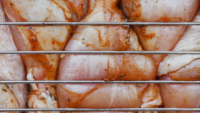Campylobacter Infections From Chicken Consumption Costs Australia Over $110 Million Annually

Image credit: senivpetro via Freepik
A recent study estimated the economic impact of foodborne campylobacterosis contracted from chicken consumption in Australia to be more than $110 million USD annually.
The study—conducted by researchers from the Australian National University, Australia’s OzFoodNet, and Agriculture and Agri-Food Canada—aimed to quantify the economic burden of Campylobacter risk factors in Australia. Analyzing data from a 2018–2019 case-control study, the researchers estimated odds ratios and attributable fractions for domestic risk factors (i.e., cooked and undercooked chicken consumption, the use of proton-pump inhibitors, contact with young dogs, and contact with chicken feces) for C. jejuni and C. coli. Burden estimates were quantified using data on national disease incidence, hospitalization, and premature mortality. Costs were applied to healthcare utilization, pain and suffering, premature mortality, and lost productivity for each risk factor.
Of the 349,000 cases of Campylobacter infection recorded in Australia from 2018–2019, 83 percent were caused by C. jejuni and 17 percent were caused by C. coli. Consumption of cooked chicken in the week prior to the onset of illness was linked to approximately 30 percent (114,000) of all campylobacteriosis cases.
Compared with the consumption of cooked chicken, the knowing consumption of undercooked chicken had a much larger adjusted odds ratio, but was much less frequently reported, so the overall attribution proportion was much smaller, amounting to 24,200 cases.
The researchers estimated that cooked chicken consumption resulted in 2,400 campylobacteriosis hospitalizations and one death, while undercooked chicken consumption resulted in 487 hospitalizations. When including all cost components for initial illness and its consequences, the researchers estimated an economic burden of $111 million USD for infection from cooked chicken and $23.1 million USD from undercooked chicken infection.
Campylobacteriosis linked to eating contaminated chicken meat accounted for approximately half of the estimated total costs of foodborne campylobacteriosis, which amounted to $253 million USD.
Looking for a reprint of this article?
From high-res PDFs to custom plaques, order your copy today!








